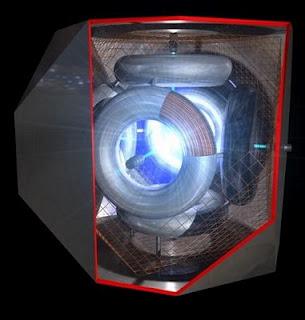Mar
7
Bussard’s EMC2 Fusion Contracts Extended
March 7, 2012 | Leave a Comment
News is out there is a contract extensions and modification for EMC2 Fusion, the theory and work of Robert Bussard, that is working to develop Inertial Electrostatic Confinement (IEC) fusion. The news was first seen at Talk Polywell and quickly picked up by Brian Wang at NextBigFuture.
The latest news is an ongoing research project going back decades. IEC comes from a very old fusion idea that can be done by high school level experimenters replicating the Farnsworth work. Dr. Bussard took the principles to a whole new level and over about 20 years found that his theorization could be made to work – fusion can occur from velocity without intense heat and pressures.
When Dr. Bussard passed on the work continued at the firm EMC2 that Bussard founded. That phase got rolling in 2008-9. The first step was to build an 8th generation of Bussard’s work called the WB-8. The acronym comes from the appearance of the device – much like the toy named a wiffle ball. From there testing and further research was to be performed. That would lead to an option for a WB-8.1 due to fund this month plus an option to build an ion gun that would be ready this month as well.
All along the way the funding requires review of the progress. Now about four years in the funds are still flowing – that strongly indicates that progress is being made.
The Bussard route to IEC fusion is raw exploration science. Nothing being designed, engineered, built and tested ever existed before. This seems to be slow work, but every step taken and tested shows how the estimation of the design and engineering is challenged in operation. An example is the lessons of handling electrons heading onto the device. It’s now known more work is needed here.
The folks at Talk Polywell have taken the news apart about as far as possible. The U.S. Navy, whose Naval Air Warfare Center is doing the contracting and funding for the research, has been researched pretty thoroughly by some very bright folks at Talk Polywell. The bits that are significant include:
The Navy seeks to extend the period of performance and add additional tasks.
The extension with added funds are expected to complete the concept exploration and technology demonstration of the Plasma WB-8.
The purpose is to overcome the problems found in the first generation electron that was to feed the electrons onto the device.
Another significant clue as to the progress is a suggestion that the project will “move on base” or simply the team and the facility will benefit from the China Lake base resources. The project may be exceeding the capabilities of a light industrial park location. China Lake has extensive industrial capabilities, a resource that perhaps the development work needs for further steps.
All this seems quite positive. Its long been known that fusion can be made to occur in an IEC, coming up on 70 years now, in fact. Bussard’s primary contribution has been to see an engineering path to exploit the nature of fusion.
A clue that lay people tend to over look, well, media, political types and competing scientists, too – all elements of larger than hydrogen size have been made by fusion – in the stars. From Helium with just two protons on up to Lawrencium, the elements have been built up by combining smaller atoms through fusion. It’s no accident that 73 elements are out there in the universe. Just what combinations there are to build the elements isn’t known with any certainty or is the list complete.
Bussard’s gift and the gifts of others in fusion research is there are ways to build up elements and release huge amounts of energy. Bussard’s work that peaked with the Wiffle-Ball design at his passing and Lerner’s Focus Fusion are but two of the possible routes for man to accomplish fusion without using a few stars.
The tantalizing thing about Bussard’s idea is when a WB is scaled up exploration into other element fusion combinations could be possible. Where that might lead is quite a thought experiment.


